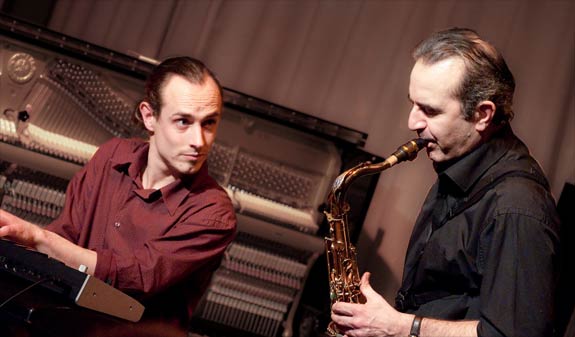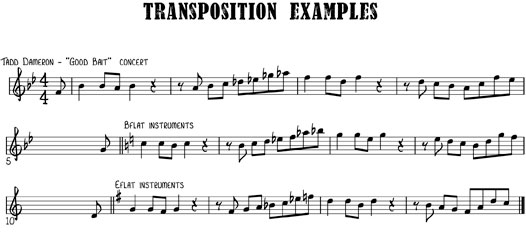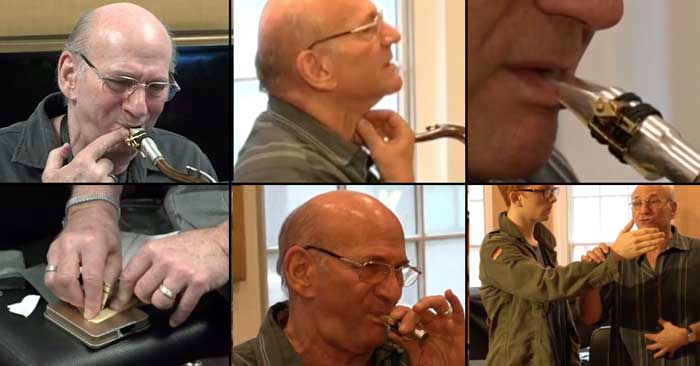The Saxophonist’s Guide To The Dreaded Art Of Transposition

I’m sure many of you remember that first time you sat down to play some sheet music with somebody playing another instrument, and most likely had that crazy realization that you might be reading the same note on the page, but different notes are coming out of your instruments!
Maybe you showed up to band practice without your method book and decided to borrow one from your friend who plays the flute. My guess is that it probably didn’t work out so well!
This article is aims to:
- Help you understand the basic principles of playing a transposing instrument
- Introduce the transpositions that every saxophonist should be able to do
- Give you some tips on improving your transposition skills to prepare you for any situation
Some Basics
As many of you know, the alto and baritone saxophones are referred to as Eb instruments, while the tenor and soprano are called Bb instruments. What this means is that when the alto or baritone saxophone plays the note C, it has to be matched by Eb on a concert pitched instrument, such as the piano, flute, or violin. Likewise, the C on the tenor and soprano has to be matched by a Bb on a concert pitched instrument.
“Why did they make this so complicated?”– you may ask. Isn’t there enough to learn about music without having to move all these notes around? Well, there’s a good reason for all this. Thankfully, we have all these different sized saxophones (imagine how boring it would be if only one of them existed!), and in order for a C to be a C on every one of them it means that the concert pitch that they produce has to be different.
Technically, all the different saxophones could be approached as concert pitch instruments. – that is, if you’re a tenor player, you could call your D a C, which is its concert pitch, but if you ever wanted to go from tenor to alto you would then have to learn different names for every note on both of them, since the pitches they make are a Perfect 4th apart. This would be a nightmare, as I’m sure you could all imagine, and if you learned this way and wanted to read something that was already transposed you’d have some problems to say the least.
Interesting note: Some of you might know there is a concert-pitched saxophone that exists called the C-melody saxophone, which was produced mainly in the 1920’s into the 1940’s, the height of the days of Tin Pan Alley. If you’ve never seen one, it looks like a cross between an alto and tenor. In fact, Lester Young’s biggest influence, Frankie Trumbauer, was a C-melody player. They have a very unique and interesting sound, but they tend to have more pitch problems and lack the projection of the more standard saxophones. Nevertheless, they did provide a solution to the issue of transposition for the people who played them.
What is transposing?
So in order to play music from a concert part and match it, we need to transpose, which means to move a collection of notes or pitches up or down in pitch by a constant interval.
So let’s start off with the alto/baritone transposition. As we discussed before, it’s an Eb instrument, so although it technically sounds a minor sixth lower than concert pitch, for the sake of practical transposition, we generally just move the notes down a minor third from concert pitch. That is, a concert C is an A for alto, a D is a B natural, an A is an F#, and so on.
Technically, the tenor sounds a 9th below concert pitch and the soprano just a step below concert pitch, but the transposition for either one involves moving the pitch up a whole step. That is, a concert C becomes a D, an E becomes an F#, an Ab becomes a Bb, as so on.
Why should I learn to transpose from concert pitch?
Yes, much of the music you play in school or buy in the store might be transposed for your instrument already, and there might even be Bb and Eb versions of your real books and favorite sheet music available to you. But it’s still important to learn to transpose.
By having this skill:
- You’ll never be reliant on the composer or bandleader having a transposed part.
- You can read from a score or a piano part.
- You can rehearse music with others using the universal language of concert pitch if you need to discuss specific notes or chords.
- You can own just one fake book and actually use it at the piano when you need to.
- And most importantly, you can make music on the spot with other instrumentalists regardless of the key of their instrument.
Learning to transpose
First of all, have a solid understanding of the principles that I went over earlier in the article. Know and understand why transposition is necessary.
If you’re new to transposition, begin to practice it with very simple, diatonic music, preferably music that you know so that you can hear when you’ve made a mistake.
Before you start playing any piece, look at the key signature and figure out what key it’s written in and what key you will be in. Tip: This is where knowing all twelve keys becomes extra important. Once you’ve identified the key you’re in, if you’re transposing a whole step up for a Bb instrument, you just move the notes up one step and make sure that you’re staying in the key. When you see an accidental, you move accordingly.
For example, let’s say you’re playing tenor and reading a concert part written in Eb major that you’re transposing to F major, and you see an A natural written. Instead of playing the Bb that’s in your key signature, you accordingly play a B natural.
As another example, if you’re playing alto or baritone and are transposing something written in the concert key of G, you will move the key a minor third (or three half-steps) down to E Major. If a C# appears in the music, you will raise the A that is normally natural in the key of E to an A#.
And don’t forget, if you’re using a lead sheet with chord symbols and want to improvise, you will also have to transpose the chords.
An Example

Take a look at the example above. You’ll see that the song is originally in the key of Bb concert.
- The Bb instruments will thus be up a step in C Major.
- The Eb instruments will move things down to G Major.
- Every note in the Bb part is then moved up a whole step.
- Every note in the Eb part is moved down a minor third.
Also, the accidentals that appear in the song are adjusted accordingly in each transposed excerpt.
Get to work
Once you grasp the basic principles of transposition for your instrument, the only way to get better at it is to do it, and then do it some more. Yes, it will seem difficult at first, but steady work to improve it will bring a huge amount of liberation to your musical life.
You might gain something by doing it for hours and hours here and there, but you’ll get a lot better at it by doing just a bit of it each day over the long term. If you’re new to it, find the simplest book of music you own and slowly work your way to music that has more difficult keys and accidentals in it. Maybe even get together with a friend to practice it, and this way you can hopefully correct each other’s mistakes.
For those of you who are already experienced with transposing from concert pitch, there are many other transpositions that are good to know. I’ve often had to transpose up or down a Perfect 4th when playing an alto part on tenor, or vice-versa, or perhaps even a clarinet part on alto if you’ve shown up to big band rehearsal and forgotten your clarinet! Also, being able to play a part written in bass clef accordingly is a useful skill as well, as is moving any transposed part back to concert pitch so that you can play it on the piano.
And for those of you who have ever played with a singer, you know that any transposition is possible, since singers often have to move music around to find the key that best suits their voice. So work on any transposition you can come up with, which is also a great help to your general musicianship.
If any of you have any tips you can share for how you learned to transpose, please feel free to share them in the comments below.
Learn with and Listen to Sam
Sam Sadigursky is currently offering online lessons through Skype and private lessons in NYC. He has given improvisation clinics across the U.S., is a regular guest professor at Hunter College, and currently performs internationally with Darcy James Argue’s Secret Society, Folklore Urbano, and others. His new book, 12 INTERVALLIC ETUDES for Saxophone, is available here. His albums can be purchased at http://samsadigursky.bandcamp.com. To find out more, visit SamSadigursky.com.






January 14, 2014 @ 8:58 am
Bari players have a trick for transposing bass clef music written at concert pitch — “imagine” the music written in treble clef, adjust keys and accidentals appropriately, and you’re golden. Useful for playing cello music on the bari.
February 23, 2014 @ 3:44 pm
Actually the alto part should be transposed up a major 6th from the concert pitch. Writing the notes a minor 3rd below concert pitch put the alto in the wrong octave.
With tenor you have to remember that the transposition is actually a major 9th above concert pitch. However if you are reading out of a fake book you can just read up a major 2nd like clarinet, soprano and tpt. Just realize that the tenor will sound an octave lower than those instruments if they are playing the same written note on the staff paper.
In college we played string quartets and transposed them as we played them. As a tenor player I had the viola part. So this is what I did. I read the alto clef part in bass clef but I adjusted the octave. So if the note to play was C, 3rd space alto clef. In bass clef is a D which is the pitch I need. To adjust for the correct octave just play the D as a 4th line D treble clef.
I hope this helps.
March 18, 2014 @ 11:44 pm
One tip for guys who want to jam with or work in Blues/Rock, or Funk bands where reading is not part of the landscape? Be ready to play fluently in E and A, which, of course puts you in F# or B if you’re a tenor player. Way, WAY back in the day, when horn players were generally the band leaders, lots of tunes were in horn-friendly keys – I know: we should be proficient in ALL keys, BUT with the advent of guitar players dominating the band scene, they like their “native” or low, open string keys like E and A. I heard Robert Plant (Led Zep) say that part of his high vocal approach was a result of Jimmy Page wanting things in E.
April 28, 2014 @ 2:45 pm
I must do so. I can do it. I know I can. I just have to put my mind to it.
November 18, 2016 @ 11:54 pm
if the key is A then for my alto sax I play in F sharp key?
June 22, 2018 @ 8:33 am
I was told by my fellow musician’s that play guitar that the song they were playing was in A minor. So I play a Alto Sax and I was trying to find that transposed Key that I would explain what key I needed to be in. I got lost!!! lol Any suggestions?? Shoot me an email if you have the answer..I could use it. :)
June 22, 2018 @ 8:42 am
For key transposition, you go down by a minor third (three semitones). Concert A minor becomes played F# minor on the alto.